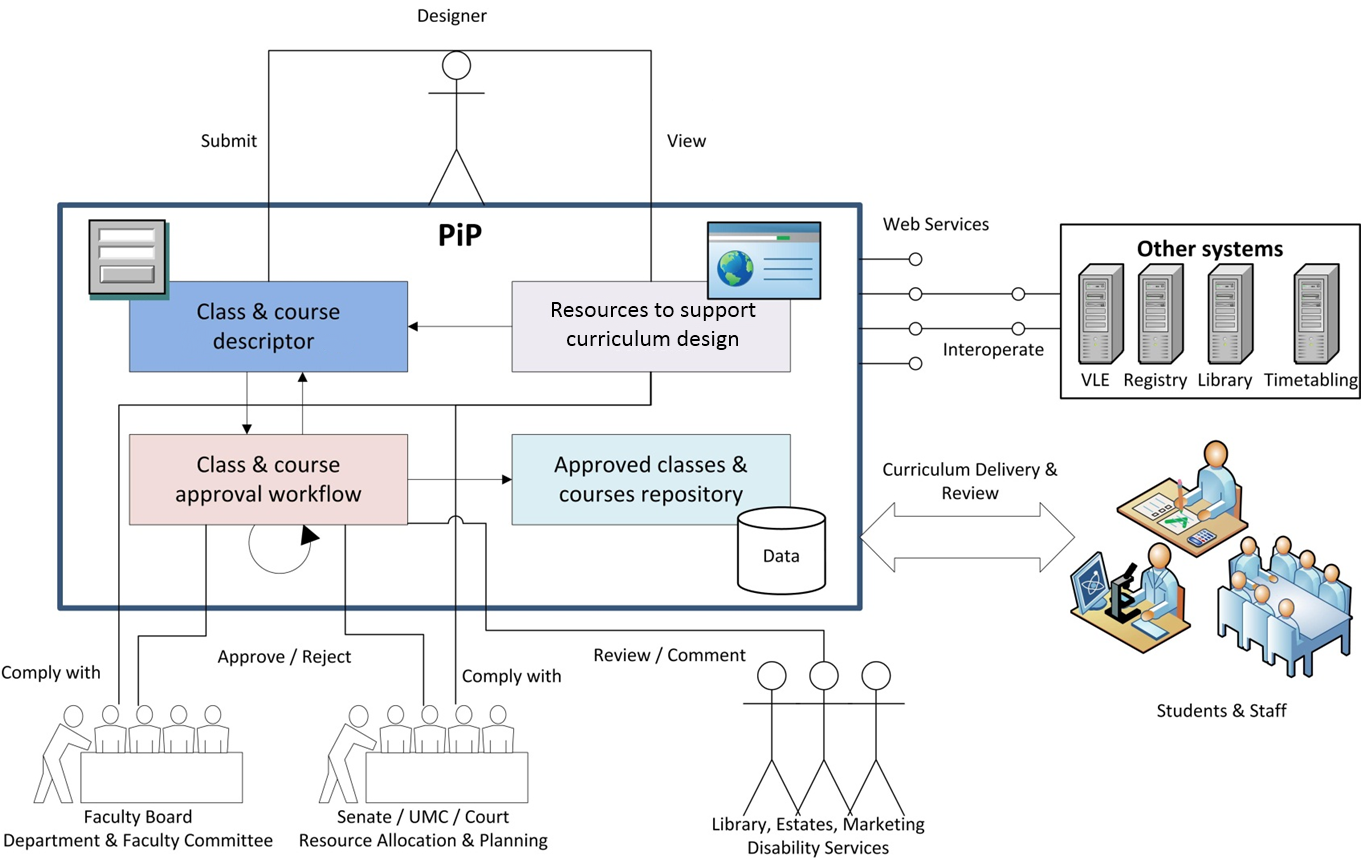The C-CAP (Class and Course Approval Pilot) System is the principal technical deliverable of the PiP Project. It is expected that improvements will be made to C-CAP throughout the embedding phase of the Project (August 2012-April 2013) and beyond. The PiP YouTube Channel provides over 50 training videos demonstrating basic C-CAP functionality. Further videos will be added in due course and C-CAP is expected to evolve technically during the embedding phase. This page provides links to Project related technical resources, including technical reports, videos and a C-CAP "cookbook"; but it also provides a brief overview of the technical solution adopted.
Technical reports and resources
Several reports were prepared to consolidate previous technical work of the project and document the technical approach adopted. These include:
- PiP Technical Development Report: SharePoint was initially chosen as a development platform for the PiP Project. A video providing a snap shot of this approach (from March 2010) is available from the PiP YouTube Channel. This technical report provides an overview of SharePoint functionality, the ways in which it can be developed and also describes the development journey undertaken to meet the system requirements as specified within the PiP Project (ultimately arriving at an InfoPath approach).
- C-CAP InfoPath 2007 Cookbook (coming soon): The "cookbook" will provides a detailed exposition of the tools and techniques used to build the system in the widely available SharePoint 2007 platform using InfoPath and is of relevance to others wishing to adopt a similar approach to tech-support curriculum design and approval. Owing to a SharePoint migration from 2007 to 2010 and the differences in implementing C-CAP on 2010, a revised and updated cookbook will be available from this page soon.
Jim Everett (PiP Project Manager) discusses the benefits of the C-CAP system:
Development architecture and technologies
The architecture of the technical solution responded to the drivers that motivated the PiP Project and was for a standalone, self-contained course and class approval system with a loose coupling to other corporate systems, thereby allowing broad stakeholder access to the contents of the system, as in the diagram below.

This approach was adopted for several reasons:
- Fundamentally, corporate systems are typically designed for data entry by a small group of specialist staff rather than the widespread participatory engagement required by the C-CAP system
- Corporate systems are also designed as the “source of truth” whereas the course and class approval process is essentially one of draft-feedback-redraft-approval with a final version only emerging at the end of the process
- The data structures in place within Student Records, Finance, etc. represent only a subset of the information used by faculty quality committees to make approval judgements; primarily because this sort of data is not relevant to the other functions
There were also pragmatic considerations that made a self-contained solution the most viable: the current corporate systems were the subject of long standing and extensive development programmes that could not easily accommodate the agile, incremental development required of PiP. Various options were also available for integrating a self-contained system with corporate systems.
Microsoft SharePoint as a development platform
The PiP Course and Class Approval system is built on Microsoft SharePoint which was identified at the start of the project as an appropriate platform to deliver the development aspirations as it was being rolled out across the University during the lifetime of the PiP project as a resource accessible to all staff, but with a particular emphasis on supporting administrative and business processes. SharePoint offers a highly flexible platform from which to offer browser-based services through a website interface that can be adapted to offer a rich range of resources and interactivity. As the funded project phase comes to an end, most of the support staff using the C-CAP system are already regular users of various services delivered through SharePoint while academic staff are exposed to the platform through several different applications such as committee management, research and knowledge exchange information, and even booking attendance at graduation events.
SharePoint offers many different development routes. Throughout the life of the project PiP developers explored a range of techniques to deliver the C-CAP system. The PiP Technical Development Report outlines the strengths and challenges of the approaches; however the main trade-off identified was the ability to customise the user interface and the underlying data structures against the technical skills required by the developer to build and maintain the system. SharePoint native features were clearly inadequate to the complex data collection, validation, review and version control that were envisaged. A custom .NET application, benefiting from the SharePoint interface, authentication and workflow features that offered the most comprehensive toolkit with which to develop a course and class approval system and initial prototypes were very promising. However, the difficulty of the approach was its requirement for specialist programming expertise to create and maintain; something which limited flexibility and sustainability.
The screencast above provides an overview of the early technical development of the PiP Project (as captured in March 2010). It provides an introduction to the principal features and functionality of an earlier iteration of PiP's technical work. The system presented in this technical preview was ultimately re-developed as the C-CAP system, using an alternative technical approach (MS InfoPath in SharePoint 2007). For this reason the video provides a useful snapshot of PiP's technical work and how it evolved throughout the lifetime of the project. The InfoPath-based approach was adopted to improve agility, adhere to the incremental systems development methodology that had been adopted, and to minimise dependency of dedicated programming support.